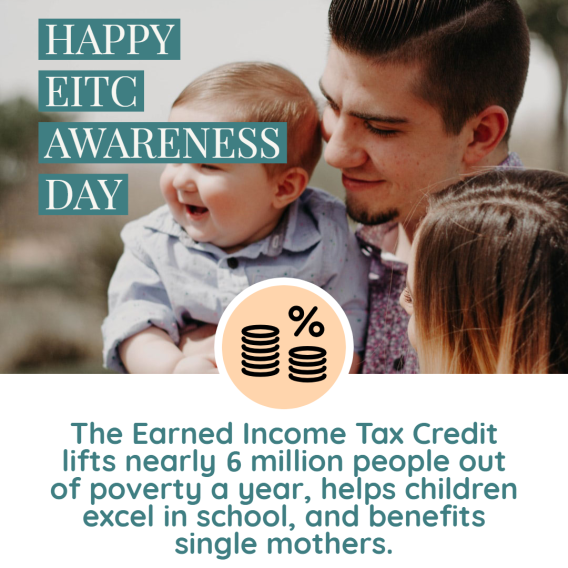The 2023 tax filing deadline is Tuesday, April 18, 2023! Preparing for the tax season can sometimes feel like a daunting task. Here’s what you need to know to get the most out of your tax refund this year.
Click on any of the following links to jump to a section:
- Child Tax Credit (CTC)
- Earned Income Tax Credit (EITC)
- Child and Dependent Care Tax Credit (CDCTC)
- Unemployment Benefits and Form 1099-G
- How to protect your identity while filing taxes.
- Filing taxes with an Individual Taxpayer Identification Number (ITIN)
- Missed out on tax credits from previous years?
- Need help filing your taxes?
Child Tax Credit (CTC)
The Child Tax Credit helps with the costs of raising children and is worth up to $2,000 per qualifying child. If you don’t owe taxes or your credit is more than the taxes you owe, you can get up to $1,500 back in your tax refund. You must have AT LEAST $2,500 of earned income in 2022 to get a CTC refund, also known as the ACTC.
You and your spouse (if you have one), can claim the CTC with either a Social Security number (SSN) or Individual Taxpayer Identification Number (ITIN). Children you claim for the credit must have an SSN.
Read What is the Child Tax Credit? To learn more about your eligibility, how much the credit is worth, and how you can get it.
Earned Income Tax Credit (EITC)
The EITC is a tax credit that may give you money back at tax time or lower the federal taxes that you owe. Whether you’re single or married, or have children or not, you could be eligible to claim this credit. The main requirement is that you must earn money from a job.
Adults not raising kids at home are eligible for a credit worth up to $560. In addition, many eligible families with children will get a larger EITC. When you file your taxes in 2023, the credit is worth a maximum of $6,935.
Read What is the Earned Income Tax Credit? to learn more about your eligibility, how much the credit is worth, and how you can get it.
Note: If you do not have a qualifying child, you MUST be between the ages of 25-64 years old to claim the credit.
Child and Dependent Care Tax Credit (CDCTC)
The CDCTC is a tax credit that helps families pay expenses for childcare needed to work or to look for work. Families can also claim this credit to pay for the care of an incapacitated spouse who is unable to care for themselves or an adult dependent. While this credit is NOT refundable, it can lower the amount of taxes you owe.
To get the credit, you will need to know how much you spent on childcare in 2022. You can refer to bank account statements, receipts, or any other documentation that tracked your expenses. The credit is worth a maximum of $1,050 for one qualifying person and $2,100 for two or more qualifying persons. You can claim qualified expenses up to $3,000 for one qualifying person or up to $6,000 for two or more qualifying persons.
Read Child and Dependent Care Credit to learn more about your eligibility, how much the credit is worth, and how you can get it.
Unemployment Benefits and Form 1099-G
If you claimed unemployment benefits for 2022, then you should receive Form 1099-G, Certain Government Payments from your state unemployment office by the end of January 2023. Your Form 1099-G will show the total amount of unemployment benefits you have received, along with any state and federal taxes you had withheld.
Unemployment benefits are considered taxable income, so you will need to report unemployment on your federal tax return.
If you received a Form 1099-G, but didn’t claim unemployment benefits, then you may be a victim of identity theft and fraud. Contact your state unemployment office to report and correct this issue.
How to protect your identity while filing taxes.
Navigating the tax filing process can be a bit tricky, especially with the increase in tax-related scams. These scams include IRS-impersonation phone calls, text messages, or emails or identity theft to claim unemployment benefits.
One way to protect yourself and your family against tax-related scams is to sign up for an IRS Identity Protection PIN (IP PIN). An IP PIN is a six-digit number that is only known by you and the IRS and can prevent someone else from filing a tax return under your Social Security number (SSN). Even if you aren’t required to file taxes, you can still get an IP PIN if you are filing a tax return to claim credits you are eligible for. The quickest way to sign up for an IP PIN is through your IRS Online account. If you don’t have an account, use this step-by-step guide to create one.
Additionally, beware of IRS impersonation scams. Know that the IRS will NOT initiate contact with you through emails, text messages, or social media to request sensitive information (like your SSN or bank account details). They will always contact you through regular mail first, delivered by the U.S. Postal Service.
If you receive an email claiming to be from the IRS, you can report it to phishing@irs.gov. This FAQ provides information on the steps you can take if you are unsure of the identity of a person claiming to be from the IRS.
Filing taxes with an Individual Taxpayer Identification Number (ITIN)
ITINs are available to people who are required to have a U.S. taxpayer identification number but who do not have, and are not eligible for, a Social Security number (SSN). Having an ITIN allows you to file taxes and claim tax credits that you are eligible for.
To apply for an ITIN, you must submit IRS Form W-7, Application for IRS Individual Taxpayer Identification Number, with your completed tax return and documentation that verifies your identity and foreign status. You can use this checklist to help prepare your ITIN application.
Read How Do You File Taxes with an Individual Taxpayer Identification Number? to learn more about how to apply, which tax credits you could be eligible for, and other benefits to getting an ITIN.
Missed out on tax credits from previous years?
In response to the COVID-19 pandemic, the government passed historic temporary expansions to tax credits for 2021. This means more people were eligible to receive more money during tax time. If you were eligible for 2021 tax credit expansions and didn’t claim them, it’s not too late. Here are the highlights:
- Child Tax Credit (CTC): The 2021 Expanded CTC made the credit available to nearly every family that is raising kids. The expansion:
- Increased the amount of the credit to $3,000 per child age 6-17 and $3,600 per child under the age of 6.
- Removed the minimum income requirement. This means that even if you don’t have income from a job, you can still get the credit.
- Made the credit fully refundable. If you don’t owe any taxes, you can get the full amount as a refund.
- Earned Income Tax Credit (EITC): The 2021 Expanded EITC is worth up to $6,728 for workers with children living with them. Significant expansions to the EITC for workers not raising children at home include:
- The age of workers eligible to claim this credit changed from 25-64 to include people 19-24 and 65 and older. Additionally, youth experiencing homelessness and former foster youth who are 18 or older are eligible.
- The credit amount is nearly tripled to $1,502.
- Additionally, there is a ‘lookback’ rule for the EITC that allows anyone eligible for the credit to choose to use their earnings from 2019 instead of 2021, if it can help you get a larger credit.
- Child and Dependent Care Credit (CDCTC): Key changes to this credit for tax year 2021 only include:
- The credit is fully refundable. This means that the credit can provide you with a tax refund even if you don’t owe taxes.
- The credit is worth up to $4,000 for one qualifying person or up to $8,000 for two or more qualifying persons.
- The amount of qualified expenses increased to up to $8,000 for one qualifying person and up to $16,000 for two or more qualifying persons.
- Stimulus payments: Congress approved 3 rounds of stimulus payments for continued COVID relief. If you have not claimed all the stimulus payments you are eligible for, you can claim them as the Recovery Rebate Credit. You will need to file a 2020 tax return for the first and second stimulus checks, and a 2021 tax return for the third stimulus check.
Didn’t get some of these credits that you think you may be eligible for? Don’t worry! You can still claim them when you file a prior year tax return. You can file a 2021 federal tax return by April 18, 2025. (You must file a 2020 tax return by May 17, 2024.)
If you were not required to file a tax return, there is no penalty for filing taxes after the April deadline. If you were required to file taxes, and you missed the deadline, filing late (and claiming credits you are eligible for) could decrease the penalty amount you may owe.
If you need to file a past due tax return, you can get help at some local Volunteer Income Tax Assistance (VITA) sites or through GetYourRefund.org. VITA sites are free and operated by volunteers that are IRS-certified. Contact your local VITA site before visiting to find out if they can file prior year tax returns.
Need help filing your taxes?
- Visit Code for America’s Get Your Refund website to connect with an IRS-certified volunteer that can help you file your taxes for free or to file your own return.
- Contact your local Volunteer Income Tax Assistance (VITA) or AARP Foundation’s Tax Aide site to get free tax help from an IRS-certified volunteer.
- Learn more about other free tax filing options.









